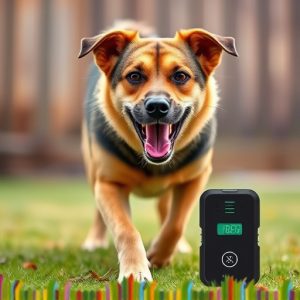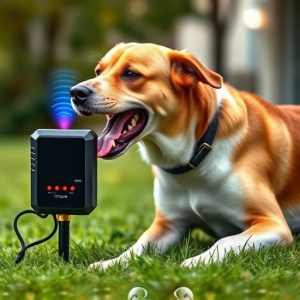Sonic Dog Training: Effectiveness, Science, and Battery Warnings
Sonic dog training utilizes ultrasonic technology (23-64 kHz) for behavioral correction through posi…….
Sonic dog training utilizes ultrasonic technology (23-64 kHz) for behavioral correction through positive and negative reinforcement. Trainers guide dogs' behavior using specific sound frequencies, navigating their emotional landscape without harm. Effective training depends on clear cues, immediate feedback, and maintaining low battery warning signs in sonic devices to avoid interruptions. Dog owners should recognize subtle 'low battery' signs like excessive barking, restlessness, or changes in routine to prevent behavioral issues. Best practices include regular inspection, cleaning, volume adjustment, close monitoring of battery life, and using reliable chargers for optimal device performance.
“Unleash a new way to train your furry friend with sonic dog training, a non-violent behavioral correction method gaining popularity. This innovative approach uses sound waves to guide canine behavior without harm. Delve into this article to explore the science behind sonic repelents and their remarkable effectiveness.
We’ll dissect how these devices work, highlighting the benefits of using low battery warning signs for optimal training. Learn to identify common warning signs of a dying battery and discover best practices for maintaining your sonic dog training device’s performance.”
- Understanding Sonic Dog Training: A Non-Violent Approach to Behavioral Correction
- How Does Sonic Dog Repellent Work? Unraveling the Science Behind It
- Benefits of Using a Low Battery Warning Sign for Effective Training
- Identifying Common Warning Signs of Low Battery in Your Dog's Behavior
- Best Practices and Tips for Maintaining Optimal Sonic Training Device Performance
Understanding Sonic Dog Training: A Non-Violent Approach to Behavioral Correction
Sonic dog training is a modern, non-violent approach to behavioral correction that uses sound waves to communicate with pets. Unlike traditional methods relying on shocks or force, it employs a gentle dog repellent to guide canine behavior. This innovative technique leverages specific frequencies and patterns to create a positive or negative reinforcement experience for the dog, encouraging desired behaviors while deterring unwanted ones. By understanding their unique language of sounds, trainers can effectively navigate a dog’s emotional landscape without causing harm.
Key to this method’s success is its ability to provide clear cues and immediate feedback. When a dog exhibits undesirable behavior, a sonic device emits a precise sound that catches the animal’s attention, signaling the need for adjustment. However, it’s crucial to recognize low battery warning signs in these devices – beeps or alerts indicating the power source needs replenishing – as they ensure the effectiveness of training sessions. Promptly addressing these warnings keeps the communication channel open, enabling continuous and successful behavioral correction.
How Does Sonic Dog Repellent Work? Unraveling the Science Behind It
Sonic dog repellents utilize high-frequency sound waves, typically above the human hearing range, to deter canine behavior. This technology is based on the principle that dogs, being more sensitive to sounds, will react negatively to the emitted noise when it triggers an uncomfortable sensation or startles them. When a sonic repellent is activated, it emits a consistent sound pressure at frequencies ranging from 23-64 kHz, which are inaudible to humans but irritating to dogs.
The ‘low battery warning signs’ for these devices can include reduced sound intensity, frequency changes, or even complete cessation of the ultrasonic emission. Regular maintenance and timely replacement of batteries ensure optimal performance. Users should be mindful of the device’s range and positioning, as effectiveness can vary based on distance and environmental factors like wind or rain, which might interfere with the transmission of these high-frequency sounds.
Benefits of Using a Low Battery Warning Sign for Effective Training
Using a low battery warning sign during sonic dog training offers several significant advantages. This simple tool helps create a predictable and positive training environment, allowing your dog to associate specific behaviors with consistent feedback. By knowing when the device is about to deactivate due to low power, you can adjust your training sessions accordingly, ensuring continuous reinforcement of desired behaviors without unwanted interruptions.
Furthermore, a visible low battery warning sign acts as a subtle dog repellent by deterring excessive barking or misbehavior triggered by sudden silence or inaudible prompts. It enables you to train with precision and effectiveness, knowing that the device will remain active for the duration of the session, enhancing overall training outcomes and strengthening the bond between you and your pet.
Identifying Common Warning Signs of Low Battery in Your Dog's Behavior
Many dog owners often overlook the subtle signs their pets give off when they’re experiencing low battery, leading to misbehavior or accidents. Identifying these warning signs early is crucial for effective sonic dog training and behavioral correction techniques. Common indicators include excessive barking, restlessness, irritability, and a sudden loss of focus. If your usually well-behaved pup starts exhibiting these traits, it could be a sign that they need a break or a change in environment to recharge.
Pay attention to changes in their routine; dogs are creatures of habit, so any deviation can throw off their balance. For instance, if your dog becomes more anxious during walks or refuses treats they normally enjoy, these could be low battery warning signs. Additionally, look out for excessive panting, yawning, or hiding—all potential indicators that your dog is feeling fatigued and needs a respite from stimuli to regain their energy levels.
Best Practices and Tips for Maintaining Optimal Sonic Training Device Performance
To ensure optimal performance from your sonic dog training device, several best practices should be followed. Regularly inspect the device for any signs of damage or wear, replacing parts as necessary to maintain its effectiveness. Keeping the device clean and dry is also crucial; moisture can interfere with electronics, so gentle cleaning with a soft cloth is recommended. Users should familiarize themselves with the device’s settings, including volume levels, to avoid excessive noise that might startle or harm pets. Customizing the sound frequency to match your dog’s sensitivity is another effective strategy for successful training.
Monitoring battery life is vital. A low battery can affect device performance and cause unexpected malfunctions. Look out for warning signs like reduced sound intensity, erratic behavior, or no response from the device. Regular charging ensures consistent use during training sessions. Additionally, using reliable chargers and avoiding overcharging can prolong the lifespan of your sonic dog repellent, maintaining its efficiency for longer.
Sonic dog training offers a humane and effective solution for behavioral correction, utilizing sound waves rather than force. By understanding how these devices work, recognizing low battery warning signs in your dog’s behavior, and adhering to best practices, you can ensure optimal performance and positive results. Remember, a well-trained dog is a happy dog, and with the right tools and approach, achieving a balanced and obedient canine companion is within reach.


